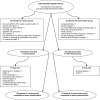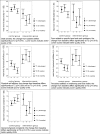Impact on quality of life of a telemedicine system supporting head and neck cancer patients: a controlled trial during the postoperative period at home
- PMID: 17213498
- PMCID: PMC2213461
- DOI: 10.1197/jamia.M2199
Impact on quality of life of a telemedicine system supporting head and neck cancer patients: a controlled trial during the postoperative period at home
Abstract
Objectives: Telemedicine applications carry the potential to enhance the quality of life of patients, but studies evaluating telemedicine applications are still scarce. The evidence regarding the effectiveness of telemedicine is limited and not yet conclusive. This study investigated whether telemedicine could be beneficial to the quality of life of cancer patients.
Design and measurements: Between 1999 and 2002, we conducted a prospective controlled trial evaluating the effects of a telemedicine application on the quality of life of patients with cancer involving the head and neck, using quality of life questionnaires that covered 22 quality of life parameters. All patients had undergone surgery for head and neck cancer at the Erasmus MC, a tertiary university hospital in The Netherlands. Patients in the intervention group were given access to an electronic health information support system for a period of six weeks, starting at discharge from the hospital.
Results: In total, we included 145 patients in the control group and 39 in the intervention group. At 6 weeks, the end of the intervention, the intervention group had significantly improved QoL in 5 of the 22 studied parameters. Only one of these five quality of life parameters remained significantly different at 12 weeks.
Conclusions: This study adds to the sparse evidence that telemedicine may be beneficial for the quality of life of cancer patients.
Figures


Similar articles
-
The validity and reliability of the Turkish version of the University of Washington Quality of Life Questionnaire for patients with head and neck cancer.Am J Otolaryngol. 2012 Jul-Aug;33(4):417-26. doi: 10.1016/j.amjoto.2011.10.014. Epub 2011 Dec 1. Am J Otolaryngol. 2012. PMID: 22137146
-
Deterioration in quality-of-life of late (10-year) survivors of head and neck cancer.Clin Otolaryngol. 2006 Jun;31(3):204-11. doi: 10.1111/j.1749-4486.2006.01188.x. Clin Otolaryngol. 2006. PMID: 16759240
-
Quality-of-life impact of participation in a head and neck cancer support group.Otolaryngol Head Neck Surg. 2007 Mar;136(3):405-10. doi: 10.1016/j.otohns.2006.10.018. Otolaryngol Head Neck Surg. 2007. PMID: 17321868
-
A structured review and theme analysis of papers published on 'quality of life' in head and neck cancer: 2000-2005.Oral Oncol. 2007 Oct;43(9):843-68. doi: 10.1016/j.oraloncology.2007.02.006. Epub 2007 Jun 27. Oral Oncol. 2007. PMID: 17600755 Review.
-
Health Literacy in Patients With Head and Neck Cancer: An Understudied Issue.JAMA Otolaryngol Head Neck Surg. 2017 Jul 1;143(7):645-646. doi: 10.1001/jamaoto.2017.0242. JAMA Otolaryngol Head Neck Surg. 2017. PMID: 28494059 Review. No abstract available.
Cited by
-
Impact of a telehealth intervention on quality of life and symptom distress in patients with head and neck cancer.J Community Support Oncol. 2015 Jan;13(1):14-21. doi: 10.12788/jcso.0101. J Community Support Oncol. 2015. PMID: 25839061 Free PMC article.
-
The Effect of Perioperative E-Health Interventions on the Postoperative Course: A Systematic Review of Randomised and Non-Randomised Controlled Trials.PLoS One. 2016 Jul 6;11(7):e0158612. doi: 10.1371/journal.pone.0158612. eCollection 2016. PLoS One. 2016. PMID: 27383239 Free PMC article.
-
Influence of travel burden on tumor classification and survival of head and neck cancer patients.Eur Arch Otorhinolaryngol. 2021 Nov;278(11):4535-4543. doi: 10.1007/s00405-021-06816-3. Epub 2021 Apr 20. Eur Arch Otorhinolaryngol. 2021. PMID: 33877433
-
eHealth Interventions for Dutch Cancer Care: Systematic Review Using the Triple Aim Lens.JMIR Cancer. 2022 Jun 14;8(2):e37093. doi: 10.2196/37093. JMIR Cancer. 2022. PMID: 35699991 Free PMC article. Review.
-
A Comparison of In-Person and Telemedicine Triage in Otolaryngology.Perm J. 2024 Dec 16;28(4):31-37. doi: 10.7812/TPP/24.077. Epub 2024 Sep 18. Perm J. 2024. PMID: 39290057 Free PMC article.
References
-
- Committee on Cancer Survivorship Improving Care and Quality of Life IoMIn: Maria Hewitt SG, Ellen Stovall, editors. From Cancer Patient to Cancer Survivor: Lost in Transition. Washington, D.C: National Academies Press; 2006. - PubMed
-
- Committee on Quality of Health Care in America IoM Crossing the Quality Chasm: A New Health System for the 21st Century. Washington, D.C: National Academy Press; 2001.
-
- Field MJ, Grigsby J. Telemedicine and remote patient monitoring JAMA 2002;288:423-425. - PubMed
Publication types
MeSH terms
LinkOut - more resources
Full Text Sources
Medical

